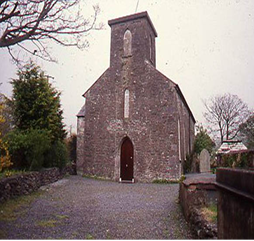 |
CHURCH OF
IRELAND
ST. JAMES CHURCH, DINGLE

Sunday Service 12 Noon
St. James Church, Dingle, is part of the Tralee and Dingle Group of Parishes.
The most westerly town in Europe, Dingle hosts a fishing fleet and a
modern marina. The present church
standing in the centre of the town, was built in 1808 and is dedicated to St.
James. In common with other churches
within the Group it occupies the site of a medieval predecessor.
The medieval
church is said to have been built by the Spaniards and it was originally a very
large structure. The dedication to
St. James probably refers to St. James of Compostela in Spain, thus emphasising
Dingle's strong links with the Iberian Peninsula.
When the Reformation reached Dingle in the 16th century, the
church passed into Protestant hands.
As the
centuries progressed the medieval church fell into disrepair.
However part of it, St. Mary's Chapel, was preserved until the later
church was built on the same site.
The present church, also dedicated to St. James, is basically an 1808
restoration of the original medieval
church, and it is located in its own grounds in Main Street, in the heart of
Dingle. The building was financed by
a gift of £1,100 from the Board of First Fruits, which was established in 1711
by Queen Anne of Great Britain, and its purpose was to build and improve the
churches and glebe houses in Ireland.
By 1837, the
building had to be enlarged and repaired and a grant of £317 was donated for the
purpose by the Ecclesiastical Board.
Further restoration work took place during 1970s.
During the 19th Century the town's principal residence was
Burnham House, the property of Lord Ventry, and at that time Lord Ventry
maintained a chaplain who was resident in the town, and who assisted in the
performance of clerical duties in the church.
In 2004
substantial repairs and renovation was necessary due to significant damp ingress
through external stonework and the poor condition of the
windows. With the help
of generous grants from Kerry County Council, The Heritage Council, RCB, Irish
Georgian Society, Dept. of Environment
and Personal donations, enabled the church to be restored and to retain
its attractive original features.
Architectural description:
Built in the
Georgian Gothic Revival Style, the church's side elevations are five bays wide
and the southwest gable includes a square-plan tower whose former spire was
taken down in 1974. A single-by,
double-height transept was also added in 1840.
All walls are of rubble stone, some rendered, and there are projecting
eaves. The church also boasts lancet
windows with framed lattice glazing as well as an elaborate chancel window with
timber tracery.
St. James'
Church has regular Sunday services but it is also used as part of the many local
festivals – such as the Storm Festival, the International Film Festival, Feile
na Bealtaine, a lecture venue, as well as hosting regular summer concerts.
It has become famous as the venue for the renowned Other Voices concerts.
It is a joy to
be able to share this amazing sacred place with so many visitors and performers.
Having sensed the ambience of this lovely building for yourself, you will
have touched the sacred that is deeply embedded in this place and in the people.
St. James the Greater
James and his
brother John were called by Jesus to be his disciples.
They were the sons of Zebedee and Salome and were known as 'Sons of
Thunder' because of their impetuous nature.
James was probably older than John and was called 'the great' or 'the
greater' to distinguish him from the other apostle, James the Less, the son of
Alphaeus, who was most likely younger or smaller in stature.
After the
death and resurrection of Jesus, James is thought to have preached in Iberia as
well as in the Holy Land. In 44 AD
he was the first of the apostles to die for his faith, when he was beheaded in
Judea by Herod Agrippa. Some believe
that his disciples carried his body by sea to Padrón on the Galician coast.
They then buried his body under what is now the cathedral in Santiago de
Compostela. His relics were
discovered sometime between 791 AD and 842AD and
Santiago de Compostela then became a place of pilrimage.
Pope Leo XIII asserted that the relics of St. James at Compostela were
authentic in a papal bull which was published on 1st November, 1884.
The Scallop Shell
There are two
versions of the legend surrounding the use of the scallop shell as symbolic of
St. James. One legend claims that
after James' death, his disciples shipped his body to the Iberian Peninsula to
be buried in what is now Santiago.
Off the coast of Spain a heavy storm hit the ship, and the body was lost to the
ocean. After some time, however, the
body washed ashore undamaged and covered in scallops.
The second
legend recounts that after James' death, his body was mysteriously transported
by a ship with no crew back to the Iberian Peninsula to be buried in what is now
Santiago. As the ship approached
land, a wedding was taking place on the shore.
The young bridegroom was on horseback and, on seeing the ship
approaching, his horse got spooked and the horse and rider plunged into the sea.
Through miraculous intervention, the horse and rider emerged from the
water alive and covered in scallop shells.